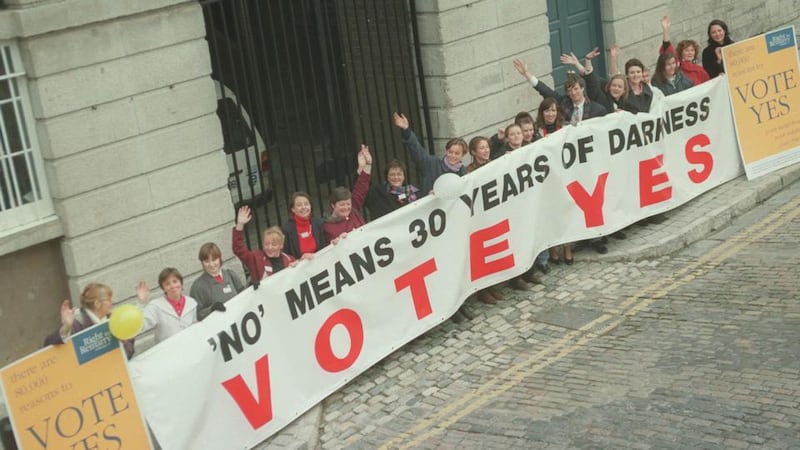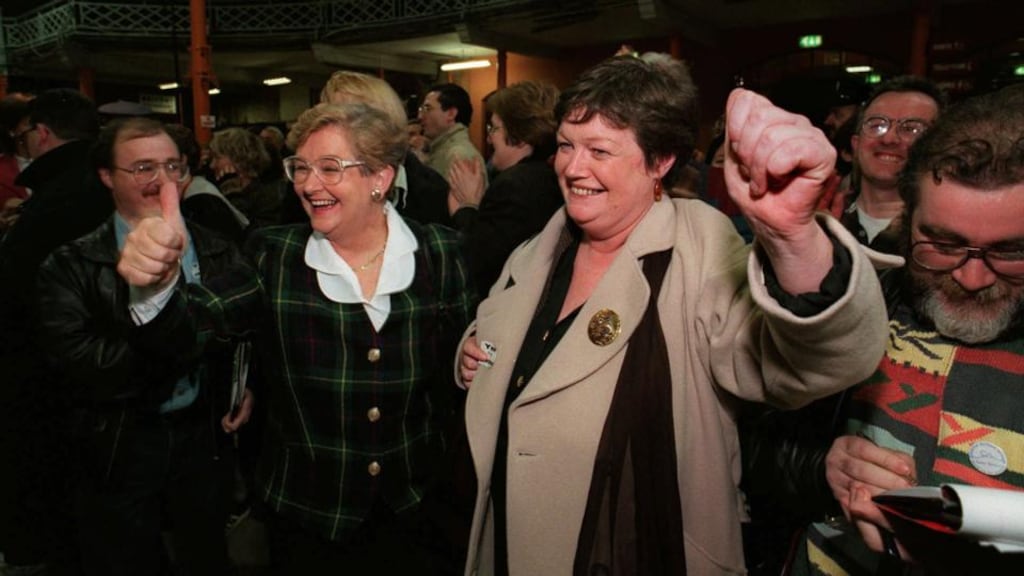It's 20 years since Ireland voted for divorce. An Irish Times series, Divorced Ireland, explores the effects of that vote on Irish life, then and since. To read the full series click here
The first point worth noting about divorce referendum day, November 24th, 1995 is that people went to vote on people’s right to remarry in this Republic knowing that more than 80,000 separated Irish citizens were trapped in a legal limbo.
The second is that the Yes side barely squeaked it. The margin was 9,114 votes or 0.6 per cent. So slight was the difference all through the count that at one point the RTÉ panel predicted it would be lost by 46 votes and the station switched to a rugby match.

The third is the turnout. Just over six in 10 people cast a vote. The Yes result may be down to persistent rain across the west of Ireland.
The fourth is that iconic billboard, “Hello Divorce . . . Bye Bye Daddy”, the work of the No Divorce campaign.
“It was like a stab,” recalls Mags O’Brien, a leading activist in the Divorce Action Group. By then, the English- born O’Brien, who had come to live in Ireland at 19 and had married an Irishman, had been separated for 15 years
The fourth is Úna Bean Mhic Mhathúna, a prominent figure of the No Divorce campaign, who gave the sound bite of the year: “G’way, ye wife-swappin’ sodomites”, she hissed, as the count in the RDS veered towards the Yes side.
Hostile end
She appeared to be speaking to journalists , but O’Brien recalls that the remark was directed at Divorce Action Group members. It was a revealingly hostile end to a campaign that had opened on the Yes side with polls showing two to one in its favour – reaching a peak at 72 per cent in May.
In Donald Taylor Black's documentary of the No Divorce campaign, Hearts and Souls, the No side's manager, Peter Scully, in blue-tinted mirror shades, embodies the turbocharged, yuppie-style, external modernity of the PR man and the internal traditionalism of the No side. Unfurling a "Hello Divorce.. . Bye Bye Daddy" poster, he "bounces it off" (a new term then) the No Divorce campaign's vice-chairman, Gerard Casey.
“Do you think it’s catchy?” inquires Scully.
“Yeah, yeah,” says Casey.
It catches precisely the tone and mood of the No campaign’s scare tactics.
The troops would not be dissuaded by any charges of scaremongering. “All of our rational points have an emotional dimension,” Casey told them during an early pep talk. The campaign should go big on emotional impact, he said.
Then again, every spin merchant knows emotional impact is the most important ingredient of any campaign, whether about Corn Flakes or the Constitution.
The No side pitched itself as David against the Goliath of government, hippies and liberals. They had Prof William Binchy, a law expert, on board, and a former High Court judge, Rory O'Hanlon – the latter distinctly unimpressed by a Mary Robinson speech "about tolerance and what not".
Depleted firepower
Meanwhile, a host of smaller, less-well-funded groups were springing up, boosting the depleted firepower of a scandal-hit Catholic Church: Muintir na hÉireann (which took a big ad on the back of The Irish Times saying "32% of Irish living in the UK are divorced"); the Christian Centrist Party; the Children's Protection Society; the Family Prayer Movement; Teachers Against the Amendment; the Committee of Lawyers against the Amendment.
Princess Diana was hardly thinking of Ireland when she gave her show-stopping Panorama interview a few days before the referendum, but such was the tension, any comment on divorce was seen as a stab or a triumph. "I think like any marriage, specially when you've had divorced parents like myself, you'd want to try even harder to make it work and you don't want to fall back into a pattern that you've seen happen in your own family," said Diana.
It was not what the Divorce Action Group wanted to hear at that stage, Mags O’Brien remembers wryly.
For many Yes voters, the referendum represented a chance for the final push to detach church from State. Ireland had become almost another country since the 1986 divorce referendum, which had been defeated by two to one. In 1980, no politician in the Dáil openly advocated divorce; by 1995, no party in the Dáil opposed it.
That intervening decade had seen Robinson elected president; the X case; the passing of two referendums relating to abortion information and the right to travel; the decriminalisation of homosexuality; and 20 women elected to the Dáil.
In a poll taken two weeks before the vote, only 25 per cent of people surveyed said they had “a great deal of trust” in church leaders, compared with 42 per cent only four years earlier.
But it was clear from the polls that religious conviction was playing a relatively insignificant role in decision-making. The 72 per cent who had supported the referendum six months earlier had hardly changed their minds based on a sudden dose of religious or moral fervour. Concerns about property, family, nation and identity came to the fore.
The confusion was best represented by the scare stories in the media that men would lose their farms or businesses while women would be left penniless.
Both statements could hardly be correct but something about those messages was getting through.
A week before the vote, the Yes side had fallen to 51.7 per cent in an Irish Times poll – just as the Supreme Court held that the use of public funds by the government to finance its print campaign in favour of a Yes was unconstitutional. This was the famous McKenna judgment, in favour of Green Party MEP Patricia McKenna, herself a Yes voter.
Mags O’Brien says now she agreed with the judgment. “I just wished she’d waited for a few weeks”, she laughs.
Galvanised
The Irish Times poll galvanised the lethargic Yes side. John Bruton, taoiseach at the time and a devout Catholic, and his ministers hit the streets and the airwaves. Bruton argued that the referendum was about equality for minorities, "about the government making the case that Northern Ireland was governed in a way that institutionalised the allegiances and symbols of its minorities – and it was therefore important that we show the State respected the minorities in its own midst".
It worked – along with the weather and the power of young, educated, urban women. The McKenna judgment would inevitably rear its head again when Des Hanafin of the Anti-Divorce Group headed for the High Court, arguing that the government advertising spend had affected the outcome, but he lost.
“Today is a momentous day,” said Mags O’Brien on RTÉ as the count wound up.
In his last column of 1995, Fintan O’Toole wrote that 1996 “will be the first year of a different kind of State, one in which people of all religions and none can, in theory at least, feel that they have the same rights of citizenship”.
Finally, the church had lost its power to shape the wider political agenda. What was left, he said, was abortion and the ownership of primary and second-level education.










